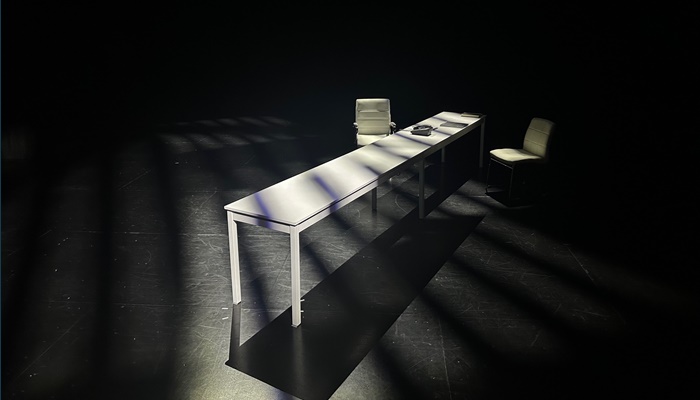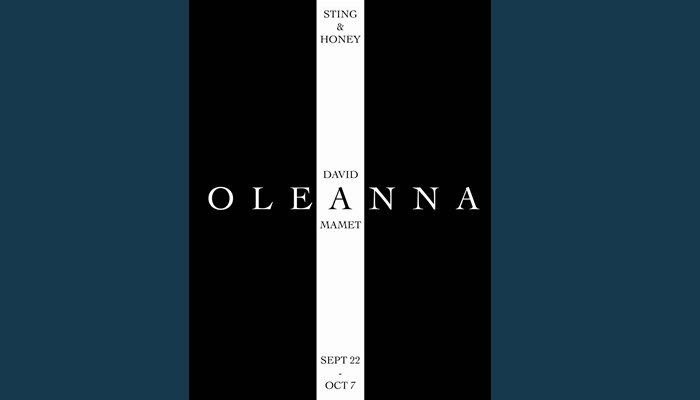SALT LAKE CITY, Utah, Sept. 27, 2023 (Gephardt Daily) — Just a quick word of warning before you see “Oleanna,” David Mamet’s 1992 two-hander currently playing in downtown Salt Lake City; the show is notorious for causing post-play arguments, so I recommend you attend with someone you don’t mind having a little verbal joust with.
The Sting and Honey Company’s production of “Oleanna” opened Friday and runs at the Regent Street Black Box at the Eccles Theater at 144 S. Regent St. until Oct. 7.
The play, which spans three acts over 90 minutes, is about a power struggle between a university professor, John, and one of his female students, Carol. She visits his office because she is having trouble understanding the material in his class, even though she has done all the assignments and reading. The situation escalates and she accuses him of sexual harassment, then the relationship between them becomes even more thorny. John’s chance of being accorded tenure, and the accompanying raise that comes with it, is at risk, which means his intention to buy a better home for he and his family, which he says is very important to him, is in jeopardy.
The name “Oleanna,” never uttered in the play, comes from a Norwegian folk song, popularised in English by Pete Seeger, which is critical of composer Ole Bull’s utopian settlements in 1850s Pennsylvania. The land in question was too full of rocks so the Norwegians sailed back home. It has been posited that the name Oleanna suggests the utopian ideal of academia which, at the play’s end, is indeed rocky. It’s never directly referred to in the play so the exact meaning of the title, like a lot of other things about the piece, is open to discussion.
The show premiered in May 1992 in Cambridge, Massachusetts, with William H. Macy and Rebecca Pidgeon. It then moved off-Broadway, to the Orpheum Theatre, that fall. Mamet adapted his play into a 1994 film of the same name, also starring Macy, this time paired with Debra Eisenstadt. The show also had a short Broadway run in 2009. The original London production was staged at the Royal Court Theatre in 1993, directed by Harold Pinter and starring David Suchet and Lia Williams. I first saw the show at the Theatre Royal in Bath in a tour subsequent to that production. I do recall that my mum and stepdad saw it too, and argued all the way home and into the night.

As Pinter notes in personal correspondence to Mamet that the former also published on his website: “There can be no tougher or more unflinching play than ‘Oleanna.’ The original ending is, brilliantly, ‘the last twist of the knife.'” I was very curious to see how the play has held up, considering it is 31 years old and pre-dated the #MeToo movement by around 14 years. Well, the answer, I believe, is that the piece could’ve been written in 2023. There is no doubting its relevance, and it really hasn’t aged a bit.
The show is directed by artistic director and founder of the company Javen Tanner and stars Tanner as John and Suni Gigliotti as Carol. It’s assistant directed by Sting and Honey associate artist Bijan J. Hosseini. The thing I really commend about this production is that, as Mamet intended, there is no character that seems to be predominantly in the right while the other is in the wrong. Rather, one sees oneself in both characters, and both have their inherent strengths and also massive weaknesses. I was actually caught off guard right at the beginning of the play, in a good way, as Tanner portrays John with a rather soft, reassuring voice. Not quiet, but somewhat soothing. And that choice really sets us up for the rest of the show. Wait, I thought to myself, isn’t John supposed to be somewhat of a insufferable, pompous ass? But he sounds so nice, so tranquil, so calm! And this is exactly what Mamet does throughout the play; turns your expectations on their head again and again. In Act I, an act of sexual harassment either does or does not occur, depending on your point of view. But Mamet, brilliantly, does not have this act occur off-stage. Rather, in the first act, we are literally watching the “harassment” happen, but what we see is absolutely nebulous and dependent on each audience member’s perception.
So in the second act when Carol accuses John, it causes each of us to cast our minds back and assess what we actually saw, and how we might have filled the gaps in our knowledge with our own narrative. In the second and third acts, Carol is attempting to claw back her power and control her story by educating the educator, and that’s when things get even more knotty.
But back to the performances; this show really lives or dies on the strength of the actors and in this case, both are extremely competent. The script must have been an absolute beast to learn; it’s full of ellipses, interruptions and half-completed sentences. Both Tanner and Gigliotti create absolutely believable arcs for their characters, and also succeed in making them beautifully multi-faceted. Sometimes it’s as if they’re both fighting for their survival, as if we are watching animals trapped in a cage. Indeed, during early performances of the play in London, the audience actually cheered at times for the final act of brutality that occurs. This begs the question, how barbaric are we as a race, especially when the pack mentality is involved?

There were only a couple of moments that didn’t land totally successfully for me; Gigliotti has been directed at two points to cry rather loudly and hysterically, at one point face down on the floor. I just wonder if it would have been more effective if we knew she was crying but was actively trying to hold it in, so as not to give up the last vestiges of her power. In the altercation near the end, we see John lose control, maybe it would be more effective if Carol did not?
The production values in this case are simple but clever. The set, also by Tanner, consists of a very long white office table with two chairs, both white, but one that is more comfortable and larger for John while Carol gets a smaller, more simple chair. The long table is initially positioned at an angle so John is seated more upstage center, to the left of the table, with more room around him, while Carol is to the right of the table with less room to move. Before the second act, the table is moved so it cuts straight down the middle of the playing space, and for the third act it is moved again so Carol has more space to move and John has less. It’s a simple convention, but also neatly depicts who has more authority at different points. The lighting by Emma Bayless is bright and stark, almost as if we are in a police interrogation room; there is nowhere to hide. Between the acts, shadows are depicted flashing on the table, accompanied by music from the Welsh alternative rock band The Joy Formidable, the lead singer of whom is based in southern Utah. The costumes by Tara Lynn Tanner are totally straightforward but work nicely.
All in all, this is a very successful production, including the conclusion of the piece, which in itself is iconic, with Pinter calling it a “perfect summation of the play. It’s dramatic ice.” And if the end of the play is dramatic ice, then much of the rest of it is dramatic fire; each character is portrayed as both the perpetrator and the victim, and, as Mamet has said, both are protagonists.
Utahns have eight chances left to see “Oleanna,” with performances Thursday to Saturday at 7:30 p.m., plus 2 p.m. Saturday matinees. For tickets and more information click here. You might leave the theater feeling wrung out and exhausted, but I can guarantee you will be thinking about the show for long after the final bows, and maybe arguing about it too.






